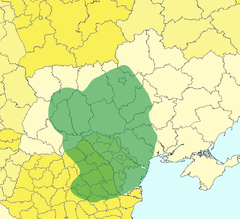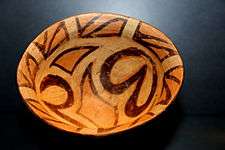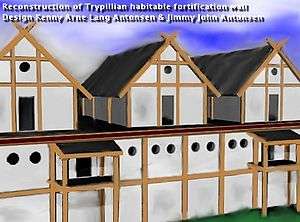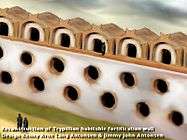Settlements of the Cucuteni–Trypillia culture
The study of the settlements of the Cucuteni-Trypillia culture provides important insights into the early history of Europe. The Cucuteni-Trypillia culture, which existed in the present-day southeastern European nations of Moldova, Romania, and Ukraine during the Neolithic Age and Copper Age, from approximately 5500 to 2750 BC, left behind thousands of settlement ruins containing a wealth of archaeological artifacts attesting to their cultural and technological characteristics.[2] Refer to the main article for a general description of this culture; this article deals with its settlements.

| Cucuteni–Trypillia culture (c. 4800 to 3000 BC) |
|---|
 Characteristic example of Cucuteni–Trypillia pottery |
| Topics |
| Related articles |
|
Yamna culture → |
Settlements
The latest research (2014) suggests that some of the largest mega sites contained as many as 3,000 structures and with the possibility of 20,000 to 46,000 inhabitants. Maidanets may have contained almost 3,000 houses and a population of anything between 12,000 and 46,000 with 29,000 as the average population figure. Dobrovody and Talianki are estimated with populations up to 16,200 and 21,000.[3][4][5]
In terms of overall size, some of Cucuteni-Trypillia sites, such as Talianki (with a population of 15,000 and covering an area of some 450 hectares – 1100 acres) in the Uman district of Ukraine, are as large as (or perhaps even larger than) the more famous city-states of Sumer in the Fertile Crescent, and these Eastern European settlements predate the Sumerian cities by more than half of a millennium. The reason that academicians have not designated the gigantic settlements of Cucuteni-Trypillia culture as "cities", is due to the lack of conclusive evidence for internal social differentiation or specialization.[6] However, there is some debate among scholars whether these settlements ought to be labeled as proto-cities.[7] The Cucuteni-Trypillia settlements were usually located on a place where the geomorphology provided natural barriers to protect the site: most notably using high river terraces or canyon edges. The natural barriers were supplemented with fences, earthworks and ditches, or even more elaborate wooden and clay ramparts.[8](p103) The role of the fortifications found at these settlements was probably to protect the tribe's domestic animal herd from wild predators.[9] Other hypotheses are that the fortifications were for protection against enemy attacks, or as a means to gather the community.[8](p112) The role of these fortifications, however, is still debated among scholars.
The most common arrangement of construction for Cucuteni-Trypillia settlements was to place most of the buildings in a circular pattern surrounding a central structure; some examples of this arrangements were found at Târpeşti, Ioblona, Berezivka, Onoprievka, and Răşcani.[8](p103) The earliest villages consisted of ten to fifteen wattle-and-daub households. In their heyday, settlements expanded to include several hundred large huts, sometimes with two stories. These houses were typically warmed by an oven, and had round windows. Some of the huts included kilns, which were used to fire the distinctive pottery for which the Cucuteni-Trypillia culture is known.
These settlements underwent periodical acts of destruction and re-creation, as they were burned and then rebuilt every 60–80 years. Some scholars have theorized that the inhabitants of these settlements believed that every house symbolized an organic, almost living, entity. Each house, including its ceramic vases, ovens, figurines and innumerable objects made of perishable materials, shared the same circle of life, and all of the buildings in the settlement were physically linked together as a larger symbolic entity. As with living beings, the settlements may have been seen as also having a life cycle of death and rebirth.[10]
As the settlements grew larger, the houses were arranged in two elliptical rows, separated by a space of 70–100 metres (220–320 feet). Each household was almost completely self-supportive within these communities, as if instead of being located within a settlement, each family was living away from town and neighbors in the country. There was a lack of public infrastructure within these settlements, which compelled the inhabitants to include all aspects of their lives within their own domicile; ovens, kilns, working, and sleeping areas were all contained within the same space as the family’s sacred altars. Thus the buildings included both the sacred and profane, which some authorities see as evidence to support the idea that the inhabitants viewed their homes as living beings.[11]
Largest settlements
.jpg)
.jpg)
The existence of the giant settlements was discovered in the 1960s, when the military topographer K.V. Shishkin noticed the presence of peculiar spots from certain aerial photographs.[7]
Scholars posit two theories regarding the impetus behind the formation of the large Cucuteni-Trypillia settlements:
- That they were created in response to the threat of invaders or attacks from people of the open steppes.
- That they appeared as a result of natural development and growth, which included the threat of inter-tribal warfare from other Cucuteni-Trypillia settlements, as the population growth exerted economic and social pressures on the limited resources of the area.[7]
Ukrainian archeologist Ivan T. Černjakov credits the large size of some of the Cucuteni-Trypillia settlements to their agricultural system, which was affected by the climatic changes over the years.[12] This can be seen by examining the historic and modern changes in sea level of the nearby Black Sea.[12]
Some of these large settlements include:

- Talianki, Ukraine – c. 3700 BCE – up to 21,000 inhabitants, up to 2,700 houses, and covered an area of 450 hectares (1100 acres).[6] Talianki was the largest Trypillia settlement around 3700 BC., after beginning of regular excavations at 1981 were explored more than 42 dwellings and few pits.
- Dobrovody, Ukraine – c. 3800 BCE – up to 16,200 inhabitants, and covered an area of 250 hectares (600 acres, explored remains of 5 dwellings.[6]
- Maydanets, Ukraine – c. 3700 BCE – up to 46,000 inhabitants, with 29,000 as the most plausible, (probably between 6000 and 9000 inhabitants) near 3600–3500 BCE, explored 34 houses and 12 pits (1972–1991)[7] up to 3,000 houses, and covered an area of 270 hectares (660 acres).[6]
- Nebelivka, Ukraine - c. 4000 BCE, up to 300 hectares (740 acres) and 15,000 residents.[7][13]
A 2009 British-Ukrainian archaeological expedition, organized by John Chapman and Mykhailo Videiko, focussed on the 300 ha mega-site of Nebelivka, Kirovograd domain, enabling the production of a 15 ha geophysics plot with over 50 burnt structures and a small number of unburnt structures, as well as pits and other anomalies. Remains of one house were excavated. This settlement, dated to B II period of Trypillia Culture, was the largest around 4000 BCE.
With the mega settlements of the Cucuteni-Trypillia culture starting in 4300 BCE the period of very large settlements would continue for almost 2,000 years. To date (2014) more than 2,440 Cucuteni-Trypillia settlements are discovered so far in Moldova, Ukraine and Romania. 194 (8%) of these settlements had an area of more than 10 hectares between 5000–2700 BCE and more than 29 settlements had an area in the range 100–450 hectares and 2,800 houses.[14][15][16][17]
The settlements were primarily administrative, military and religious centres and not for crafts. The typical Trypillia hierarchy was one dominant "capital" with a population up to 15,000 people and more than 100 hectares, this capital was surrounded by satellite towns typically in the size range 10–40 hectares and villages in the range of 2–7 hectares. The Capital controlled territories as far away as 20 km (12,5 mi) from the center.[18]
The latest research indicates that the settlements had three level settlement hierarchy, with the possibility of state-level societies. An excavated mega-structures suggests the presence of public buildings for meetings or ceremonies.[19]
The following are a list with the largest settlements with approximate time of peak population. Remember, population estimates of ancient settlements should always be taken with caution, with different interpretations depending on the scholar.
| 5000–4600 BCE | 4300–4000 BCE | 4000–3600 BCE | 3600–3200 BCE | 3200–2750 BCE |
|---|---|---|---|---|
| Mogylna. 500–800 | ||||
| Vesioly Kut. 5,000–7,500 | ||||
| Nebelivka. 10,000–15,000 | ||||
| Trypillia. 6,600–10,000 | ||||
| Myropillya. 6,600–10,000 | ||||
| Kharkivka. 3,300–6,500 | ||||
| Glubochek. 3,300–6,500 | ||||
| Pianeshkove. 3,300–6,500 | ||||
| Vil’khovets. 3,300–6,500 | ||||
| Fedorovka, Ukraine. 3,300–6,500 | ||||
| Tomashovka. 6,600–10,000 | ||||
| Maydanets. 10,000–46,000 | ||||
| Dobrovody. 10,000–16,200 | ||||
| Talianki. 6,300–15,000–30,000 | ||||
| Khrystynivka. 3,300–6,500 | ||||
| Volodymyrivka. 3,300–6,500 | ||||
| Peregonivka. 3,300–6,500 | ||||
| Vladyslavcyk. 3,300–6,500 | ||||
| Chychyrkozivka. 10,000–15,000 | ||||
| Kvitky. 5,000–7,500 | ||||
| Ksaverove. 3,300–6,500 | ||||
| Yaltushkiv. 3,300–6,500 | ||||
| Sushkivka. 3,300–6,500 | ||||
| Stina, Ukraine. 3,300–6,500 | ||||
| Romanivka. 3,300–6,500 | ||||
| Rozsokhuvatka. 3,300–6,500 | ||||
| Apolyanka. 3,300–6,500 | ||||
| Apolyanka. 3,300–6,500 | ||||
| Kosenivka. 3,300–6,500 | ||||
| Kocherzhyntsi. 3,300–6,500 | ||||
 Interconnected Cucuteni-Trypillian houses in the Maydanets settlement. Based on research done in 1996 by the Ukrainian scholar Mikhailo Videĭko.[6]
Interconnected Cucuteni-Trypillian houses in the Maydanets settlement. Based on research done in 1996 by the Ukrainian scholar Mikhailo Videĭko.[6]- Interior reconstruction of a Cucuteni-Trypillian house in the Archaeology Museum Piatra Neamț, Romania.
 Reconstruction of a Cucuteni-Trypillian hut, in the Tripillian Museum, Trypillia, Ukraine.
Reconstruction of a Cucuteni-Trypillian hut, in the Tripillian Museum, Trypillia, Ukraine.- A scale reproduction of a Cucuteni–Trypillia village.

 Habitable wall fortification, central part of Maydanets 4000 BCE
Habitable wall fortification, central part of Maydanets 4000 BCE
_Maydanets.jpg) Reconstruction of public house - sanctuary from Maydanets.
Reconstruction of public house - sanctuary from Maydanets.
Ultimately, the large scale of the Cucuteni-Trypillia settlements may have contributed to the downfall of their society, according to a theory that attributes their collapse to ecological factors.[20] Due to a dramatic worldwide climate change around 3200 BCE, the area of the Cucuteni-Trypillia culture would have been plunged into a devastating "Dust Bowl" type of drought. With their reliance on agriculture to produce food, feeding the many inhabitants of these large-scale settlements would have been unsustainable, leading to the dramatic end of the Cucuteni-Trypillia farming society, and replaced by the more drought-appropriate pastoral nomadic society of the Proto-Indo-Europeans that followed.[21]
See also
- Prehistoric Romania
- History of Ukraine
- Prehistory of Southeastern Europe
- Neolithic Europe
- Chalcolithic Europe
References
- superimposed on modern state and provincial borders; following Igor Manzura, “Steps to the Steppe: Or, How the North Pontic Region was Colonized,” Oxford Journal of Archaeology XXIv.4 (2005), pp. 313–338.
- Mallory, James P (1989). In search of the Indo-Europeans: language, archaeology and myth. London: Thames and Hudson. ISBN 0-500-05052-X. OCLC 246601873.
- Diachenko, Aleksandr; Francesco Menotti (2012). "The gravity model: monitoring the formation and development of the Tripolye culture giant-settlements in Ukraine". Journal of Archaeological Science. 39 (8): 2810–2817. doi:10.1016/j.jas.2012.04.025.
- Müller, Johannes. "High precision Tripolye settlement plans, demographic estimations and settlement organization". Cite journal requires
|journal=(help) - Müller, Johannes; Rassmann, Knut; Videiko, Mykhailo (2016-01-22). Trypillia Mega-Sites and European Prehistory: 4100-3400 BCE. ISBN 9781317247913.
- Khol, Philip L. (2002). "Archeological transformations: crossing the pastoral/agricultural bridge". Iranica Antiqua. Leiden: E.J. Brill. 37: 151–190. OCLC 60616426. Retrieved 21 November 2009.
- Videĭko, Mikhailo Yu (2002). History of Discovery and Investigations Трипільські протоміста. Історія досліджень [Trypillian proto-cities: History of investigations] (in Ukrainian). Kiev: Tovarystvo Kolo-Ra. pp. 103–125. OCLC 52587844.
- Bailey, Douglass W. (2005). Prehistoric figurines: representation and corporeality in the Neolithic. London; New York: Routledge. OCLC 56686499.
- Marinescu-Bîlcu, Silvia (1981). Tîrpeşti: from prehistory to history in eastern Romania. British archaeological reports international series. 107. Translated by Bolomey, Georgeta. Oxford: British archaeological reports (B.A.R.). ISBN 0-86054-125-8. OCLC 16546798.
- Gheorghiu, Dragoş (2006), "A fire cult in South European Chalcolithic traditions? On the relationship between ritual contexts and the instrumentality of fire", in Barrowclough, David A.; Malone, Caroline (eds.), Explorations into the conditions of spiritual creativity in prehistoric Malta, Cult in context: comparative approaches to prehistoric and ethnographic religious practices, Oxford: Oxbow, pp. 269–284, ISBN 978-1-84217-303-9, OCLC 309578661, archived from the original on 2008-05-11
- Menotti, Francesco (2007), "The Tripolye house, a sacred and profane coexistence!", WAC-6 Sixth World Archaeological Congress, 6th World Archaeological Congress (WAC6), Dublin, OCLC 368044032
- Mantu, Cornelia-Magda (2000). "Cucuteni–Tripolye cultural complex: Relations and synchronisms with other contemporaneous cultures from the Black Sea area". Studia Antiqua et Archaeologica. Iași, Romania: Iași University. VII: 267. OCLC 228808567.
- Müller, Johannes; Rassmann, Knut; Videiko, Mykhailo Yu (22 January 2016). Trypillia Mega-Sites and European Prehistory: 4100-3400 BCE. ISBN 9781317247920.
- Videiko, M. Yu (2011). Trypillia culture proto-cities after 40 years of invistigations. Trypillian Civilization journal.
- Rudenko, Anatoly (2014). "Trypillian giant settlements". academia.edu.
- Kohl, Philip L. (2007). The Making of Bronze Age Eurasia. Cambridge University Press. ISBN 9781139461993.
- Baumer, Christoph; Tauris, I.B. (2012). The History of Central Asia: The Age of the Steppe Warriors. ISBN 9781780760605.
- Videiko, M. Yu. Trypillia culture proto-cities: After 40 years of investigations. Trypillian Civilization Journal. ISSN 2155-871X.
- Chapman, John; Videiko, Mikhail; Gaydarska, Bisserka; Burdo, Natalia; Hale, Duncan; Villis, Richard; Swann, Natalie; Thomas, Nathan; Edwards, Patricia; Blair, Andrew; Hayes, Ashley; Nebbia, Marco; Rud, Vitalij (2014). "The planning of the earliest European proto-towns: A new geophysical plan of the Trypillia mega-site of Nebelivka, Kirovograd Domain, Ukraine". Antiquity. 88 (339).
- Anthony, David W. (2007). The horse, the wheel, and language: How Bronze Age riders from the Eurasian steppes shaped the modern world. Princeton, NJ: Princeton University Press. ISBN 978-0-691-05887-0.
- Todorova, Henrietta (1995). Bailey, Douglass W.; Panayotov, Ivan (eds.). "The Neolithic, Eneolithic, and Transitional in Bulgarian prehistory". Prehistoric Bulgaria. Monographs in world archaeology. Madison, WI: Prehistoric Press (22): 79–98. ISBN 1-881094-11-1.
External links
| Wikimedia Commons has media related to Tripolye culture. |
| Wikimedia Commons has media related to Cucuteni culture. |
- Archaeological Park Cucuteni The website for the multi-institutional and international project entitled "Archaeological Park Cucuteni", which seeks to reconstruct the museum at Cucuteni, Romania, and to more effectively preserve this valuable heritage site (in English and Romanian).
- Cucuteni Culture The French Government's Ministry of Culture's page on Cucuteni Culture (in English).
- Cucuteni Culture The Romanian Dacian Museum page on Cucuteni Culture (in English).
- The Trypillia-USA-Project The Trypillian Civilization Society homepage (in English).
- Трипільська культура в Україні з колекції «Платар» Ukrainian language page about the Ukrainian Platar Collection of Trypillian Culture.
- Trypillian Culture from Ukraine A page from the UK-based group "Arattagar" about Trypillian Culture, which has many great photographs of the group's trip to the Trypillian Museum in Trypillia, Ukraine (in English).
- The Institute of Archaeomythology The homepage for The Institute of Archaeomythology, an international organization of scholars dedicated to fostering an interdisciplinary approach to cultural research with particular emphasis on the beliefs, rituals, social structure and symbolism of ancient societies. Much of their focus covers topics that relate to the Cucuteni-Trypillian Culture (in English).
- The Vădastra Village Project A living history museum in Romania, supported by many international institutions.